2. 安徽省矿产资源与矿山环境工程技术研究中心, 合肥 230009;
3. 江西省地质矿产勘查开发局赣西北大队, 九江 332000
2. Anhui Province Engineering Research Center for Mineral Resources and Mine Environments, Hefei 230009, China;
3. Northwest Geological Branch, Jiangxi Bureau of Geology and Mineral Resources, Jiujiang 332000, China
碲是一种重要的稀散金属,在现代工业和国防建设中有着广泛的应用,被誉为“现代工业、国防和尖端技术的维生素”(Ba et al., 2010),被世界上多国列为关键金属矿产(Schulz et al., 2017; 蒋少涌等, 2019; 翟明国等, 2019)。碲在材料、冶金、化学、催化剂、生物工程、电子、太阳能电池板、半导体等领域发挥着重要作用(Zweibel, 2010; Turner et al., 2012; 程籽毅等, 2020),是当前我国矿床学领域重点关注的关键金属矿产资源(毛景文等, 2019; 翟明国等, 2019; 侯增谦等, 2020)。
研究表明,碲在地壳中的含量极低,只有n×10-9~10n×10-9 (McDonough and Sun, 1995),难以形成独立矿床。目前仅报道的独立碲矿床是我国四川石棉县大水沟碲矿床(银剑钊等, 1994; 毛景文等, 1995; Mao et al., 2002)和瑞典的Kankberg碲矿床(Schulz et al., 2017)。其余碲矿床主要以共伴生矿床形式产出,如斑岩-矽卡岩型矿床、岩浆铜镍硫化物矿床、VMS矿床、IOCG矿床、浅成低温热液矿床、造山型和卡林型金矿等(Andreeva et al., 2013; Schulz et al., 2017; Keith et al., 2018; 刘家军等, 2020; Jian et al., 2021)。其中,斑岩-矽卡岩型矿床提供了世界上绝大多数的铜和金主要资源量(Sillitoe, 2010),而碲在铜精粉和金矿石中作为副产品可被回收利用(Cook et al., 2009; Keith et al., 2018; George et al., 2019),因此,斑岩-矽卡岩型矿床是重要的碲来源之一(Schulz et al., 2017)。
长江中下游成矿带是我国重要的铁铜金多金属成矿带之一(宁芜研究项目编写小组, 1978; 翟裕生等, 1992; 常印佛等, 2017),发育多个斑岩-矽卡岩型矿床,其伴生的关键金属具有重要的工业价值和研究意义。近些年,有关关键金属的文献理清了该地区的关键金属的总体特征,如毛景文等(2019)系统总结了中国进入21世纪以来不同类型关键金属矿床的主要勘查成果及全球关键金属矿产研究新进展时,列举了长江中下游斑岩-矽卡岩Cu-Au-Mo-Fe成矿带中发现的镓、镉、铊、锗、硒、铟、碲和铼多种稀散元素富集;谢桂青等(2020)初步总结了长江中下游氧化性富金斑岩-矽卡岩矿床中有关碲、硒、铊可能富集机制;周涛发等(2020)通过对长江中下游成矿带内斑岩-矽卡岩型铜铁金矿床中镉、钴、硒、碲和铼等关键金属元素矿产的赋存状态及富集特征进行了初步总结, 梳理了矿床主矿种和伴生关键金属元素的对应关系。虽然前人对长江中下游成矿带关键金属矿产分布、关键金属赋存状态等进行了一定研究,但对于关键金属碲在典型矿床中赋存状态、碲的富集成矿机制等研究还较为薄弱。本文以长江中下游成矿带九瑞矿集区的城门山矿床为实例,开展碲的赋存状态和沉淀机制研究,以期为斑岩-矽卡岩型共伴生碲矿床研究提供资料,同时引起工业界对关键金属碲的勘查与利用的重视。
1 地质背景长江中下游成矿带位于扬子板块北缘,南北两侧分别为大别山造山带和江南隆起带(Mao et al., 2011; Zhou et al., 2015; 常印佛等, 2012)。该成矿带经历了多期复杂的构造-岩浆演化过程,形成了极具特色的断隆区、断凹区及隆凹过渡的次级构造单元,成矿带目前由8个矿集区组成(周涛发等, 2017; 毛景文等, 2020; 吕庆田等, 2020),分别为鄂东南矿集区、九瑞矿集区、安庆-贵池矿集区、铜陵矿集区、庐枞矿集区、宁芜矿集区、宁镇矿集区和宣城矿集区(图 1)。
长江中下游成矿带勘查和研究程度高,前人开展过大量工作,主要集中在成岩成矿动力学背景(Pan and Dong, 1999; Sun et al., 2007; 周涛发等, 2008; Xie et al., 2008; Li et al., 2010)、壳幔岩浆作用(周涛发等, 2011; Mao et al., 2011; Zhou et al., 2015; Chen et al., 2020; Yan et al., 2021)、成岩成矿时代(Xie et al., 2011; 周涛发等, 2011; He et al., 2013; 张舒等, 2017; Liang et al., 2018; 张赞赞等, 2018)、成矿过程及其演化(Zhao et al., 1999; Xie et al., 2011; Yu et al., 2011; 周涛发等, 2012; Cao et al., 2012; 邵辉等, 2020; Xiao et al., 2021; Wang et al., 2021; Xu et al., 2021)、成矿流体及成矿物质来源(侯增谦等, 2004; Zhou et al., 2011; Zhang et al., 2017a; Wang et al., 2021)、矿床成因(周涛发等, 2017; Zhang et al., 2017b; Nie et al., 2017; Liu et al., 2018a; Liang et al., 2018; 赵新福等, 2020; Liu et al., 2020)等诸多方面,并取得丰富的研究成果。
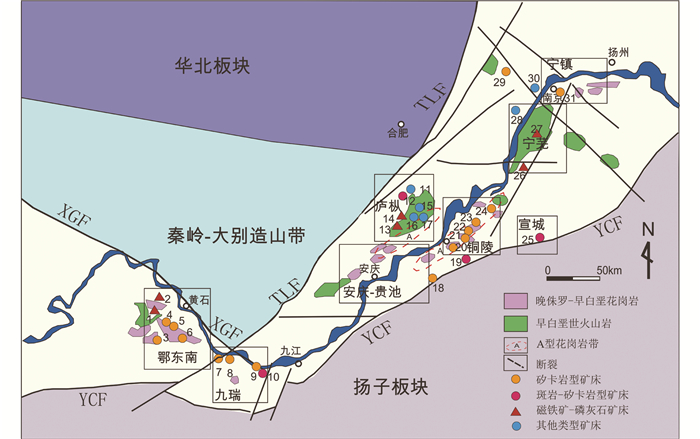
|
图 1 长江中下游成矿带含共伴生关键金属元素矿床分布图(据Mao et al., 2011; 周涛发等, 2020修改) 1-程潮铁矿床(伴生镓);2-张福山铁矿床(伴生镓);3-铜山口铜金矿床(伴生硒/碲);4-鸡冠咀金矿床(伴生硒/碲);5-铜绿山铁铜矿床(伴生硒/碲);6-阮家湾钨矿床(伴生镓/镉);7-鸡笼山金铜矿床(伴生硒/碲);8-封三洞金铜矿床(伴生硒/碲);9-洋鸡山金矿床(伴生硒/碲);10-城门山铜金矿床(伴生硒/碲);11-东顾山钨钼矿床(伴生铼);12-沙溪铜金矿床(伴生硒);13-罗河-小包庄铁矿床(伴生镓);14-泥河铁矿床(伴生镓);15-矾山明矾石矿床(伴生镓);16-石门庵铜矿床(伴生硒/镓);17-井边铜矿床(伴生硒/镓);18-黄山岭-桂林郑铅锌钼矿床(伴生镉);19-湛岭铼钼矿床(伴生铼);20-金口岭铜金矿床(伴生镓);21-狮子山铜金矿床(伴生硒/碲/钴);22-荷花山铅锌矿床(伴生镓镉);23-桥硫铁矿床(伴生硒/镉/钴);24-姚家岭铜锌金矿床(伴生硒/镉/钴);25-茶亭铜金矿床(伴生镉镓);26-姑山铁矿床(伴生镓);27-凹山铁矿床(伴生镓);28-香泉铊矿床;29-琅琊山铜金矿床(伴生硒);30-万寿山锗矿床;31-栖霞山铅锌矿床(伴生镉).TLF-郯城-庐江断裂;XGF-襄樊-广济断裂;YCF-杨兴-常州断裂 Fig. 1 Distribution of deposits containing Te resource in the Middle-Lower Yangtze River Valley Metallogenic Belt (modified after Mao et al., 2011; Zhou et al., 2020) |
近年来,在长江中下游成矿带勘查和研究中发现,一些关键金属元素含量较高(韩颖霄和谢桂青, 2016; 谢桂青等, 2019, 2020; 周涛发等, 2020),并具有工业利用价值,如铜陵新桥矿床中已探明伴生的硒资源量1340t,镉资源量725t,钴资源量6077t(周涛发等, 2020);铜陵冬瓜山矿床中普遍含硒、镉和钴(Wang et al., 2015),主要金属矿物黄铁矿、黄铜矿种硒含量一般在10×10-6~300×10-6之间,镉含量一般在30×10-6以上,钴含量平均为30×10-6,最高可达100×10-6,选矿实验也表明镉、硒、钴达到工业综合利用要求。结合前人资料和课题组最新研究成果,本次梳理了该成矿带代表性共伴生碲矿床特征(表 1)。长江中下游成矿带稀散元素碲以伴生矿种产出,同时,碲与硒具有密切关系,如凤凰山铜矿床硒与碲含量相当,主要寄主在黄铁矿、黄铜矿中(周涛发等, 2020)。碲共伴生的矿床主要有矽卡岩型矿床、斑岩-矽卡岩型矿床、磁铁矿-磷灰石矿床,以及其他类型矿床(包括浅成低温热液型,热液型等)(表 1)。这些共伴生碲矿床除安庆-贵池矿集区目前尚无相关报道外,在其余7个矿集区均有发育(图 1)。
|
|
表 1 长江中下游成矿带代表性共伴生碲矿床特征表 Table 1 Summary of characteristics of representative deposits containing critical metal of tellurium in the Middle-Lower Yangtze River Valley Metallogenic Belt |
城门山矿床位于九瑞矿集区,是长江中下游地区典型的斑岩-矽卡岩型矿床,Cu金属量307万t,平均品位0.75%,Au金属量43.6t,平均品位0.24g/t(Pan and Dong, 1999; 叶少贞等, 2019),该矿床以铜为主,共伴生硫、铅、锌、银、钼、铁等元素,随着近些年找矿勘查工作不断深入,在城门山矿区边部又新增了一些铜铅锌矿体,如金鸡窝矿区新增铜多金属资源量相当于一个大型矿床规模(叶少贞等, 2019)。中国矿床发现史江西卷编委会(1996)公开报道城门山矿床伴生碲5571t,是目前长江中下游成矿带已知的最大的共伴生碲矿床。
矿区出露的地层复杂,从老到新依次为中志留统罗惹坪组、上志留统纱帽组;上泥盆统五通组;上石炭统黄龙组;下二叠统梁山组、栖霞组、茅口组,上二叠统龙潭组、长兴组;下三叠统大冶组等(图 2)。地层产状总体走向为70°,倾角为45°~60°,倾向北西。其中黄龙组是地层中主要的赋矿层位之一,控制了碳酸盐岩交代型(层控硫化物型)矿体的空间展布,二叠系、三叠系地层是矽卡岩型矿体的主要赋矿围岩(图 3)。矿区内主要发育北东东,北东-北北东,北西-北北西走向的三组断裂,控制岩体和矿体的产出。岩浆岩主要为花岗闪长斑岩和石英斑岩,形成时代140~147Ma(Li et al., 2010; Yang et al., 2011; Xu et al., 2021),花岗闪长斑岩与斑岩-矽卡岩矿化密切相关,是矽卡岩致矿岩体。
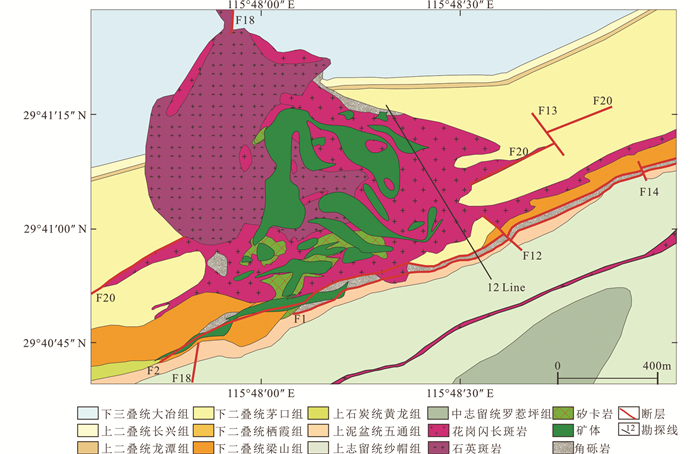
|
图 2 城门山矿区地质简图(据叶少贞等, 2019修改) Fig. 2 Geological map of the Chengmenshan Cu deposit (modified after Ye et al., 2019) |

|
图 3 城门山矿区12线勘探线剖面图(据叶少贞等, 2019修改) Fig. 3 The profile of exploration line 12 in Chengmenshan deposit (modified after Ye et al., 2019) |
城门山矿区围岩蚀变和矿化类型多样,根据矿体的产出部位和矿石矿物的组合特征,矿体可划分为三种类型:斑岩型铜矿体、矽卡岩型铜矿体和碳酸盐交代型矿体(层状矿体)。斑岩型铜矿体主要赋存在花岗闪长斑岩内,多呈细脉状、网脉状产出(图 4b, c),铜品位较低,一般不超过1%。其中,铜资源量在斑岩型矿体中占比约5%(孔凡斌, 2014; 叶少贞等, 2019)。围岩蚀变主要有钾长石化、绢云母化、高岭土化、硅化等(图 5a),主要金属硫化物有黄铁矿、黄铜矿、闪锌矿、方铅矿等(图 5b)。
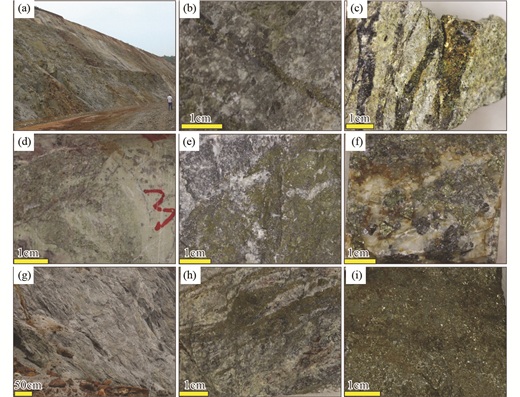
|
图 4 城门山矿床典型矿石类型照片 (a)采坑照片;(b)细脉状斑岩型矿石;(c)脉状斑岩型矿石;(d)浸染状矽卡岩铜矿石;(e)块状矽卡岩矿石;(f)脉状矽卡岩矿石;(g)层状黄铁矿矿石;(h)纹层状矿石;(i)块状黄铁矿黄铜矿矿石 Fig. 4 Typical ore types of Chengmenshan deposit |
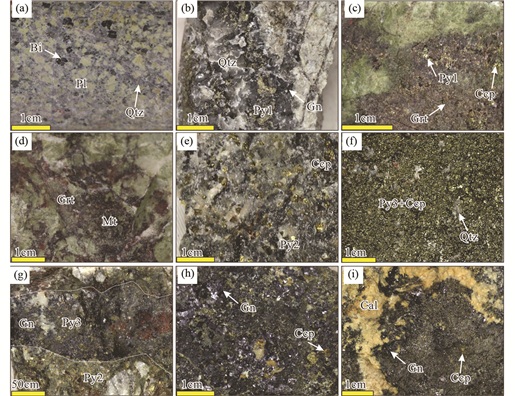
|
图 5 城门山矿床典型矿物组合及蚀变照片 (a)花岗闪长斑岩中黑云母绿泥石化;(b)斑岩型矿石石英脉中的黄铁矿Py1;(c)矽卡岩中的黄铁矿Py1+黄铜矿+石榴子石;(d)矽卡岩中的石榴子石+磁铁矿;(e)浸染状矿石中的黄铁矿Py2+黄铜矿;(f)块状矿石中黄铁矿Py3+黄铜矿+石英;(g)脉状矿石中的方铅矿+黄铁矿组合;(h)块状矿石中方铅矿+黄铜矿组合;(i)方铅矿+黄铜矿组合被后期的方解石脉穿插.Bi-黑云母;Cal-方解石;Ccp-黄铜矿;Gn-方铅矿;Grt-石榴子石;Mt-磁铁矿;Pl-斜长石;Py-黄铁矿Qtz-石英 Fig. 5 Typical mineral assemblages and alteration of Chengmenshan deposit |
矽卡岩型矿体主要在岩体和地层之间的接触带,铜金属量在矽卡岩型矿体中约占52%(孔凡斌, 2014),主要经济组分为铜,品位变化大,伴有金、银、铅锌、硫等。矽卡岩型矿石主要呈浸染状、块状、脉状产出(图 4d-f),围岩蚀变包括矽卡岩化、硅化、碳酸盐化等。金属矿物有黄铜矿、辉铜矿、斑铜矿、黄铁矿、少量方铅矿、闪锌矿等(图 5c-f),其中斑铜矿与黄铜矿及黄铁矿常共生一起。碳酸盐交代型矿体主要分布在石炭系和远离接触带的二叠系碳酸盐岩地层中,多顺层产出,受地层和构造共同控制,整体顺层延伸性好,铜金属量在该类型矿石占比约43%,绝大部分的金、银、铅、锌都赋存在碳酸盐交代型矿体中(叶少贞等, 2019; 吴火星等, 2020)。该类型矿石主要呈层状、纹层状、块状等产出(图 4g-i),矿物组合复杂多变,金属矿物主要有黄铁矿、方铅矿、闪锌矿、黄铜矿等(图 5g-i),其中方铅矿与闪锌矿常共生一起。围岩蚀变包括硅化、碳酸盐化(图 5i)等。
3 矿相学特征城门山矿床矿石构造主要为浸染状、网脉状、细脉浸染状和致密块状,局部可见条带状构造,矿石结构以半自形-他形粒状结构为主,也有少数矿石为自形粒状结构。矿区内铜金各类型矿石中不同矿物组合主要由热液交代作用形成,其矿物组合和生成顺序均与花岗闪长斑岩体密切相关,因此,可将斑岩型矿石、矽卡岩型矿石和层状碳酸盐交代型矿石归为一个成矿系统,结合脉体穿插关系及矿物生成先后顺序,本次研究将成矿作用划分为成矿前干矽卡岩阶段和湿矽卡岩阶段,主成矿石英-硫化物阶段和成矿后碳酸盐阶段(图 6)。

|
图 6 城门山矿床矿物生成顺序 Fig. 6 Mineral-forming sequence of the Chengmenshan deposit |
矽卡岩阶段主要由石榴石、辉石、阳起石、绿泥石、绿帘石等组成;石英硫化物阶段主要金属矿物包括黄铁矿、黄铜矿、斑铜矿,辉铜矿、黝铜矿、闪锌矿、方铅矿、辉钼矿、磁铁矿等(图 7);碳酸盐阶段矿物主要有石英、方解石等。
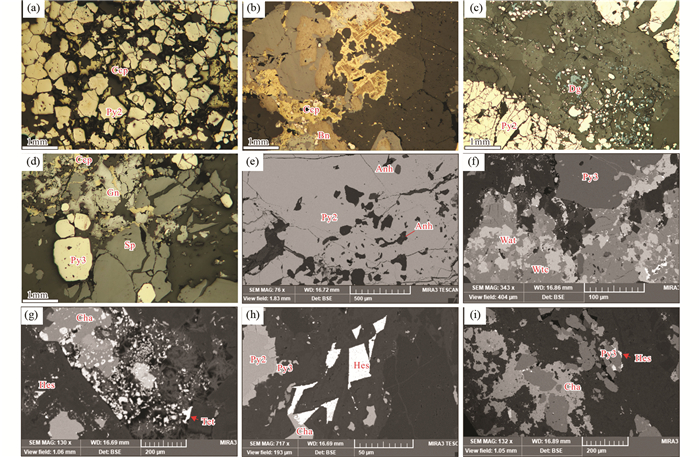
|
图 7 城门山矿床典型矿物组合及碲矿物BSE照片 (a)黄铁矿Py2与黄铜矿密切共生;(b)黄铜矿与斑铜矿共生;(c)蓝辉铜矿与黄铁矿Py2;(d)黄铁矿Py3,闪锌矿,方铅矿矿物组合;(e)黄铁矿Py2中包裹硬石膏;(f)硫铋铜矿与碲黝铜矿共生;(g)辉铜矿、碲银矿、辉碲铋矿共生;(h)自形粒状碲银矿,Py2边缘被Py3交代;(i)碲银矿矿物围绕黄铁矿颗粒边缘发育.Bn-斑铜矿;Dg-蓝辉铜矿;Sp-闪锌矿;Hes-碲银矿;Cha-辉铜矿;Tet-辉碲铋矿;Wtc-硫铋铜矿;Wat-碲黝铜矿;Anh-硬石膏 Fig. 7 Reflected and polarized light photomicrographs of typical telluride minerals from the Chengmenshan deposit |
主成矿石英-硫化物阶段中黄铁矿类型多样,具有多个世代,但在斑岩型矿石、矽卡岩型矿石与碳酸交代型矿石中具有一致的形态和结构,以及共生矿物组合。黄铁矿Py1通常为半自形和多边形粒状结构,晶形完整,边界平直,部分呈碎裂状,并具有拼接性,粒径较大。黄铁矿Py2多与含铜矿物共生一起,在斑岩型、矽卡岩型、碳酸盐岩交代型矿石中广泛分布,粒径大小不一,边界多为不规则状,内部多包裹有独居石、白钨矿、硬石膏等矿物(图 7e)。黄铁矿Py3在矽卡岩矿石中多以孤立自形黄铁矿形式出现,部分与黄铜矿共生,在碳酸盐岩交代型矿石中通常与矿石矿物黄铜矿、闪锌矿、方铅矿,脉石矿物白云石,石英,方解石等共生一起,晶形不一,粒径变化范围大,主要介于0.1mm到1mm不等。
黄铜矿矿相学特征相对单一,主要为半自形粒状到他行粒状结构,以浸染状、脉状、块状集合体分布在各类型矿石中,与黄铁矿Py2和Py3密切共生。含铜矿物主要在矽卡岩型矿石和碳酸盐岩交代型矿石中,主要有黄铜矿、斑铜矿、黝铜矿、吉硫铜矿等,常与闪锌矿及方铅矿共生,局部可见含铜矿物边缘被铅锌矿物交代,或者闪锌矿中可见黄铁矿、黄铜矿乳滴状结构,表明铅锌矿物形成略晚于黄铜矿和黄铁矿等矿物。
碲银矿矿物粒径一般较小,多小于10μm,较大颗粒粒径可达30μm(图 7h),围绕黄铁矿、黄铜矿等矿物独立产出,或围绕黄铁矿黄铜矿等矿物边缘发育。闪锌矿、方铅矿在主成矿阶段较晚时候出现,方铅矿呈自形粒状结构,部分可见交代铁铜矿物。闪锌矿多呈半自形粒状或不规则状,呈浸染状或脉状分布在矽卡岩型和碳酸盐岩型矿石中。铅锌矿物多以闪锌矿+方铅矿+黄铁矿+黄铜矿矿物共生组合出现。
4 样品采集及测试方法本次研究主要在勘探线12线、8线、1线系统采集了各类型矿石样品,自花岗闪长斑岩体到矽卡岩,再到碳酸盐交代型矿体,样品在空间上基本覆盖矿区各类型矿石样品(图 3),满足研究需要。样品在垂向上自上而下,由岩体到矽卡岩到地层,具有一定分带性,在水平上具有一定延伸性。
电子探针分析在中国地质地质调查局西安地质调查中心自然资源部岩浆作用成矿与找矿重点实验室完成,仪器型号为JXI8100,元素含量分析的测试条件为:加速电压20kV,电流20nA;束斑大小为5μm,当矿物颗粒较小时,采用1μm。
LA-ICP-MS硫化物原位微量元素含量分析和矿物元素面扫描分析均在合肥工业大学矿床成因与勘查技术研究中心(OEDC)矿物微区分析实验室完成。激光剥蚀系统为Cetac Analyte HE,ICP-MS为Agilent 7900。激光剥蚀过程中采用氦气作载气、氩气为补偿气以调节灵敏度。硫化物微量元素含量利用多个参考玻璃(NIST610、NIST612、BCR-2G)和硫化物标样(MASS-1)作为多外标单内标的方法进行定量计算(Liu et al., 2010),详细的仪器操作条件和数据处理方法参考文献(汪方跃等, 2017)。
黄铁矿面扫描分析仪器与点分析仪器参数一致,数据处理与成图采用实验室内部设计软件LIMS (基于Matlab设计)完成(汪方跃等, 2017; Xiao et al., 2018)。整个分析过程中仪器信号漂移、背景扣除等均有软件自动完成。精确含量矫正采用100%归一法进行元素含量计算。
5 测试结果 5.1 电子探针分析结果石英-硫化物主成矿阶段发育各种硫化物和碲化物。电子探针测试分析结果显示碲的独立矿物主要有两类,一类为碲化物,如碲银矿、碲铅矿、碲铋银矿等(图 7g, h),其元素组合主要Te-Ag,Te-Pb,Te-Ag-Bi;另一类为硫化物,如辉碲铋矿、硫楚碲铋矿、碲黝铜矿等(图 7f, i),元素组合为Te-Bi-S和Te-Cu-S-Bi-As(表 2)。
|
|
表 2 城门山矿床不同矿石类型中金属矿物电子探针分析结果(wt%) Table 2 The electron microprobe analyses of ore minerals from the Chengmenshan deposit (wt%) |
碲银矿主要分布在碳酸盐岩交代型矿石中,其中Ag元素含量为57.18%~61.31%,Te元素含量为36.35%~39.45%,含有少量的Se和Cd,分别为0.01%~0.02%和0.29%~0.36%。辉碲铋矿中Te元素含量介于34.09%~34.96%之间,Bi含量为59.50%~59.69%,S含量较低(4.63%~4.87%),含少量的Se(0.17%~0.21%)、Cr(0.26%~0.29%)、Ag(0.13%~0.18%)。硫楚碲铋矿2个探针分析点Te含量分别为26.57%和27.14%,Bi含量分别为67.17%和66.38%,S含量为4.87%和4.99%,含少量的Se和Cd元素。碲黝铜矿中Cu含量介于41.42%~46.45%之间,S含量介于24.11%~25.21%之间,As、Bi、Te元素含量差别较大,其中As含量高值约最小值的2倍,介于5.75%~10.87%之间,Te含量介于1.08%~12.82%之间。
本次电子探针测试铜矿物主要有黄铜矿、辉铜矿、吉硫铜矿、脆硫铜铋矿等。辉铜矿样品Cu含量介于78.49%~80.33%之间,S含量介于20.38%~21.45%之间,含有少量的Ag(0.13%~0.27%)、Zn(0.08%~0.17%),Te含量最高可达0.09%。2个探针分析点脆硫铜铋矿中Bi含量分别为42.41%和39.98%,Cu含量为37.79%和40.56%,S含量为19.02%和19.34%,此外As、Se、Cr、Ag、Te均有显示,Te最高为0.04%。黄铜矿样品中未检测到Te。
黄铁矿样品较为均一,Fe含量介于45.68%~45.96%之间,S含量介于54.00%~54.56%之间,此外含有少量的Co、Cu等,Te也有显示,介于0.01%~0.02%之间。辉铋矿样品Bi含量为78.21%~79.09%,S含量为18.35%~18.61%,Se含量介于0.17%~0.23%之间。方铅矿相对均一,Pb与S含量大于99%,含有少量Cd(0.07%~0.15%)。闪锌矿中Cd含量介于0.32%~0.33之间,变化范围小。
5.2 LA-ICP-MS微量元素分析结果黄铜矿和黄铁矿LA-ICP-MS微量元素测试分析汇总表分别见表 3和表 4。
|
|
表 3 城门山矿床黄铜矿LA-ICP-MS微量元素测试结果(×10-6) Table 3 The LA-ICP-MS trace elements of chalcopyrite from the Chengmenshan deposit (×10-6) |
|
|
表 4 城门山矿床黄铁矿LA-ICP-MS微量元素测试结果(×10-6) Table 4 The LA-ICP-MS trace elements of pyrite from the Chengmenshan deposit (×10-6) |
斑岩型矿石中黄铜矿Te含量为0.66×10-6~1.52×10-6,平均0.24×10-6;矽卡岩型黄铜矿Te含量为0.15×10-6~20.50×10-6,平均2.72×10-6;碳酸盐岩交代型矿石中黄铜矿Te含量最高达3.44×10-6,平均0.61×10-6。黄铜矿中Se在斑岩型矿石、矽卡岩型矿石、碳酸盐岩交代型矿石分别为34.06×10-6~50.28×10-6、12.21×10-6~68.20×10-6、9.64×10-6~31.24×10-6,平均值分别为42.84×10-6、35.63×10-6、17.87×10-6,Se在矽卡岩型矿石中含量变化范围最大。斑岩型矿石中黄铜矿的Cr含量为0.38×10-6~103.0×10-6,平均27.77×10-6;矽卡岩型黄铜矿Cr含量为0~31.89×10-6,平均4.79×10-6;碳酸盐岩交代型矿石中黄铜矿Cr含量最高达71.08×10-6,平均7.85×10-6。黄铜矿中Co在斑岩型矿石、矽卡岩型矿石、碳酸盐岩交代型矿石最高值分别为0.85×10-6、26.26×10-6、12.28×10-6。斑岩型矿石中黄铜矿In含量为47.49×10-6~58.75×10-6,平均54.76×10-6;矽卡岩型黄铜矿In含量为0.01×10-6~72.66×10-6,平均28.59×10-6;碳酸盐岩交代型黄铜矿In含量为11.29×10-6~282.0×10-6,平均118.1×10-6,In在该类型黄铜矿中变化范围最大,平均值最高(图 8)。黄铜矿中Sn含量在斑岩型、矽卡岩型、碳酸盐岩交代型平均值分别为55.25×10-6、33.84×10-6、234.6×10-6;其中Au,Tl等元素含量较低,大多数样品小于5×10-6。
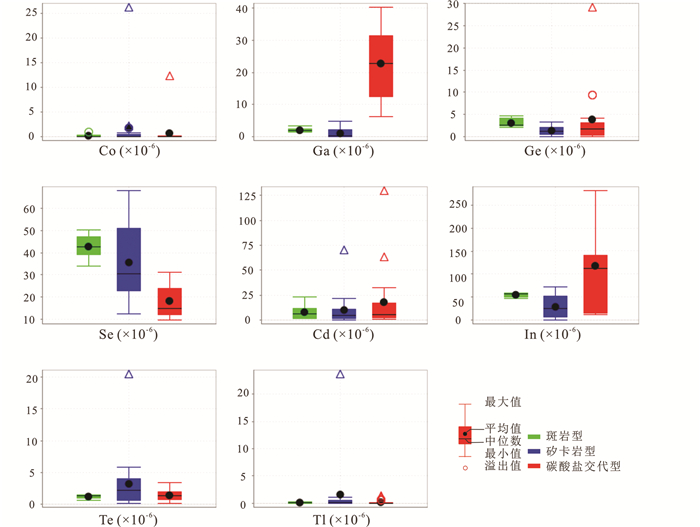
|
图 8 城门山矿床黄铜矿微量元素箱型图 Fig. 8 Box and whisker plots of trace elements contents of chalcopyrite from Chengmenshan deposit |
根据岩相学观察,可将黄铁矿分为多个世代。为了查明Te是否在寄主矿物黄铁矿中富集,其赋存状态如何,本次研究采用矿石类型划分,按照不同矿石类型中黄铁矿微量元素含量进行分析。黄铁矿中Te在斑岩型矿石中含量介于0.57×10-6~93.06×10-6之间,平均20.37×10-6,Te在矽卡岩型矿石介于0.02×10-6~36.30×10-6之间,平均5.37×10-6,Te在碳酸盐岩交代型矿石中含量介于0.01×10-6~172.9×10-6之间,平均22.89×10-6。Se在斑岩型矿石含量介于10.48×10-6~32.70×10-6之间,平均21.68×10-6;Se在矽卡岩型矿石含量介于2.15×10-6~79.83×10-6之间,平均30.35×10-6;Se在碳酸盐岩交代型矿石含量介于0.64×10-6~38.51×10-6之间,平均8.73×10-6。黄铁矿中As元素含量极差较大,在不同类型矿石含量差别也十分明显(图 9),As斑岩型、矽卡岩型、碳酸盐岩交代型最高值分别为30.46×10-6、98.99×10-5、16.83×10-4,呈数量级的变化趋势。In、Sn、Sb、Tl、Cd含量在斑岩型矿石含量极低,基本低于检测限。Ge含量在斑岩型、矽卡岩型、碳酸盐岩交代型三种类型矿石中含量差别不大,其平均值分别为1.95×10-6、1.74×10-6、1.58×10-6。

|
图 9 城门山矿床黄铁矿微量元素箱型图 Fig. 9 Box and whisker plots of trace elements contents of pyrite from Chengmenshan deposit |
由微量元素分析结果可知,Te在碳酸盐岩交代型矿石样品的黄铁矿中含量相对较高,最高可达172.9×10-6,因此,选择该类型典型黄铁矿样品进行了LA-ICP-MS面扫描分析,以查明Te在单颗粒样品中分布情况及其各元素之间的关系。单颗粒黄铁矿样品的LA-ICP-MS元素面扫结果显示核边结构特征(图 10)。Te元素在黄铁矿中分布不均匀;Fe,Au含量在黄铁矿中分布基本均匀;Te、Se、Ge、Cd、In、Tl等元素具有正相关关系,核部相对低,边部显示富集特征;Co元素在黄铁矿核部相对富集,但在核部富集区显示出不均一特征。更为细致的现象是在黄铁矿边缘出现的Ni升高,而Co降低的现象指示温度降低特征;黄铁矿边部相对富集Te、As、Se、Ge、Ag、Cd、In、Tl等元素,表明其后期低温流体相对富集这些关键金属元素,这与碳酸盐岩交代型矿石中较为发育低温矿物组合基本一致。

|
图 10 城门山矿床典型碳酸盐岩交代型矿石中黄铁矿LA-ICP-MS面扫描图像 Fig. 10 LA-ICP-MS maps of pyrite grains in typical carbonate metasomatic ore of Chengmenshan deposit |
研究表明,碲的赋存状态主要有两种形式,一种为独立矿物,另一种为类质同象替换(钱汉东等, 2000; Audétat and Zhang, 2019; 方贵聪等, 2019; Jian et al., 2021)。碲在地壳中呈分散状态,实验研究表明Te与Se等稀散元素在岩浆熔离作用中, 绝大部分呈类质同象分散于硫化物晶格中,只有在硫的浓度明显降低的条件下,也就是大多数硫化物晶出以后,Te与Au、Ag、Bi、Ni等结合才能形成独立的碲化物。本文电子探针结果显示,城门山矿床碲主要以独立矿物形式存在,在碳酸盐岩交代型矿石中较为发育,形成的碲化物包括碲银矿和碲铋银矿等。碲的硫化物包括辉碲铋矿、硫楚碲铋矿、碲黝铜矿等。值得注意的是,在碲黝铜矿中Te含量并不稳定,标准碲黝铜矿分子式为Cu12(Te, Sb, As)4S13,Cu含量45.79%,S含量25.03%,Te、Sb、As作为组合可以替换,然而本次电子探针测试结果显示是Bi、Te、As这三个元素,Bi元素含量相对稳定,可能替换Sb元素,Te与As元素含量具有此消彼长关系,可能发生相互替换。
在黄铁矿、黄铜矿等矿物中有Te的显示,探针测试结果最高可达0.02%,表明Te元素少量寄主在黄铁矿、黄铜矿矿物中,呈类质同象替换形式存在。LA-ICP-MS黄铜矿和黄铁矿微量元素分析显示,Te含量在不同类型矿石中含量差别较大。矽卡岩黄铜矿中Te含量变化范围大于碳酸盐岩交代型。碳酸盐岩交代型矿石中黄铁矿Te含量最高,在单一颗粒中Te含量分布也不均匀且高Te含量主要发育在黄边部区域,显示出Te等关键金属在形成单颗粒矿物较晚阶段富集特征(图 10)。
6.2 碲的沉淀机制不同学者对碲的富集沉淀机制有不同的观点:流体可通过混合作用、水岩反应、沸腾作用将HTeO3-还原,或将Te22-、HTe-氧化从而导致碲沉淀(Evans et al., 2006; Grundler et al., 2013)。近中性到酸性、还原的含水流体不能携带大量碲,因此,天然碲将是稳定的(Afifi et al., 1988; Ciobanu et al., 2006; Saunders and Brueseke, 2012)。城门山矿床中未见独立天然碲矿物,表明成矿流体不太可能是酸性、还原流体,而可能是中性到碱性、氧化流体。
文春华等(2012)对城门山矿床开展了流体包裹体研究工作,在不同阶段脉体识别出富液相、含子晶、富气相、纯气相和富二氧化碳多种类型包裹体,并获得温度、盐度、密度等参数,揭示流体演化过程中曾多次出现沸腾作用,致使铜金等硫化物沉淀。其中获得辉钼矿中伴生的石英脉中流体包裹体均一温度范围为310~486℃,黄铁矿和黄铜矿中伴生的网状脉石英流体包裹体均一温度介于251~489℃之间,黄铁矿和零星黄铜矿伴生的粗脉石英中流体包裹体均一温度为230~590℃,可能反映了多阶段流体叠加特征。上述不同阶段成矿流体均包含300℃,该成矿温度位于不同阶段脉体可控范围内,是一个可能的共性温度。根据矿物组合关系,如黄铜矿和斑铜矿共生,磁黄铁矿和黄铁矿共生等,同时结合不同温度的碲逸度-硫逸度相图,可以反算出某一特定温度下可能的碲逸度和硫逸度。本次研究以300℃的logfTe2-logfS2相图为底图,结合矿物岩相学,矿物对在相图中出现的极值位置,如斑铜矿、黄铁矿、黄铜矿矿物组合代表最高硫逸度,黄铁矿、磁黄铁矿矿物组合代表最低硫逸度,据此计算出300℃下硫逸度介于-6.8~-11.4,碲逸度介于-7.8~-14.8(图 11)。

|
图 11 城门山矿床矿物logfTe2-logfS2关系图(300℃)(底图据Afifi et al., 1988) Fig. 11 The mineral logfTe2-logfS2 relationship diagram of Chengmenshan deposit (300℃) (base map after Afifi et al., 1988) |
沸腾作用会导致流体中αHS-(aq)、αHTe-(aq)、αO2和αH2的降低及fO2(g)和fH2S(g)的增高(Cooke and Mcphail, 2001; Zhai et al., 2018),从而促进反应式(1)-(5)向右进行,使方铅矿、闪锌矿、黄铁矿和自然金沉淀,并且αH2的降低会使反应式(6)向右进行,沉淀自然金。虽然沸腾作用可以触发方铅矿、闪锌矿、黄铁矿和自然金的沉淀,但不会导致碲金矿和碲银矿的大量沉淀(反应式(7)-(9))。城门山矿床中含铜矿物复杂,蓝辉铜矿的出现通常表明为高硫环境(Perello′ et al., 2001; Takács et al., 2017),当硫化物发生沉淀时,会使流体中的fS2(g)急剧减小(图 12),温度降低,fTe2升高,fTe2/fS2升高,当fTe2/fS2达到碲铋矿-辉铋矿的矿物反应平衡线时,碲化物发生沉淀(图 12)。沸腾作用会导致流体中的气相大量释放(Lowenstern, 2001),Te易进入气相并在气相中聚集并迁移(Grundler et al., 2013)。当气相与围岩接触时会发生冷凝作用,Te会以液滴状返回流体,使流体局部区域αHTe-(aq)骤然增高并达到饱和,促使反应式(8)和(9)向右进行,形成Au-Ag碲化物。

|
(1) |

|
(2) |

|
(3) |

|
(4) |

|
(5) |

|
(6) |

|
(7) |

|
(8) |

|
(9) |

|
图 12 城门山矿床矿物温度-logfS2关系图(底图据Einaudi et al., 2003) Fig. 12 The relationship between temperature and logfS2 of Chengmenshan deposit (base map after Einaudi et al., 2003) |
城门山矿床中蓝辉铜矿、斑铜矿、黄铁矿及磁黄铁矿的矿物组合表明体系中硫逸度是变化的,根据温度和硫逸度相图,城门山矿床矿石矿物沉淀可能经历的演化路径如图 12所示,成矿早阶段的高温阶段,其矿物组合主要以Cu-Au-Mo元素为主,主成矿阶段斑铜矿、蓝辉铜矿、黄铁矿等组合表明为高硫逸度,同时在该类型黄铁矿中多可见硬石膏包裹体(图 7e),随着温度的降低,硫逸度也降低,其降低幅度远大于温度;当硫逸度和温度逐渐降低时,致使体系碲逸度升高,当碲逸度积累到一定程度,到达沉淀条件,形成碲化物。其他典型矿床实例如希腊Perama Hill浅成低温Au-Ag-Te-Se矿床在成矿流体演化过程中,其lgfTe2逐渐升高、lgfS2和lgfSe2逐渐降低被认为是碲化物沉淀的重要因素(Voudouri et al., 2011)。Zhai and Liu (2014)通过大量热力学计算和模拟,获得了三道湾子碲金矿床的成矿物理化学条件,并指出流体的沸腾作用和气体的冷凝作用导致流体pH值升高、氧逸度降低是诱发碲化物富集和沉淀的主要机制。综上,城门山矿床成矿流体演化过程中,硫逸度和温度的逐渐降低,碲逸度升高,可能是该矿床碲化物沉淀的主要机制。
6.3 成矿物质来源硫同位素作为成矿物质来源的有效指示剂,根据矿床中S同位素的组成, 可以判断硫化物成矿物质的来源(Shu et al., 2013; Zhai et al., 2018; He et al., 2021; Çiçek et al., 2021),对探讨矿床成因具有重要意义。赵瑞等(1985)对城门山矿床不同矿石类型中的黄铁矿矿物开展了S同位素研究,结果显示,斑岩型矿石中的黄铁矿S同位素介于+2‰~+2.5‰之间,矽卡岩型矿石中黄铁矿S同位素介于+2.6‰~+3.6‰之间,碳酸盐岩交代型矿石中黄铁矿S同位素为+2.1‰~+5.3‰。Du et al. (2020)对城门山矿床中的黄铁矿开展原位S同位素分析,将黄铁矿划分为四种类型,分别为同生沉积期的黄铁矿Py1、粗粒自形黄铁矿Py2(成矿早阶段)、主成矿阶段的黄铁矿Py3和热液晚阶段Py4。由于同生沉积黄铁矿主要表现为胶状结构,是沉积成因还是热液成因目前尚存争议,本次研究暂不讨论,剩余3种类型黄铁矿原位δ34SV-CDT主要介于0‰~4.5‰之间,呈正态分布(图 13b),成矿早阶段粗粒自形黄铁矿Py2硫同位素介于0.5‰~3.5‰之间,主成矿阶段黄铁矿Py3硫同位素略低于早阶段,介于0‰~3.0‰之间,热液晚阶段黄铁矿Py4硫同位素分布广泛,介于0.5‰~4.5‰之间。

|
图 13 城门山矿床S同位素直方图 (a)数据据赵瑞等(1985);(b)数据据Du et al. (2020) Fig. 13 Histograms of S isotope data of Chengmenshan deposit |
研究表明,金属矿床中硫同位素来源主要有以下3种:(1)深源岩浆硫,其成分接近陨石的硫同位素组成,以δ34S峰值接近0为明显特征(Schlegel et al., 2017; Ma et al., 2018),并且变化范围小,集中于-3.0‰~+3.0‰(Cook, 1996)。(2)地壳硫,在沉积、变质和岩浆作用过程中,地壳岩石的硫同位素组成变化较大(Siedenberg et al., 2016; Hammerli et al., 2021)。(3)混合硫,岩浆在上升的侵位过程中混染了地壳物质,硫同位素组成变化较大(Liu et al., 2018b; Adam et al., 2020; Schrader et al., 2021)。大多数成因上与花岗岩侵入体有关的矿床,其硫化物样品δ34S值应在-3‰~+7‰之间,因此,城门山矿床中无论是单颗粒黄铁矿硫同位素还是原位硫同位素均显示深部岩浆来源特征(赵瑞等, 1985; Du et al., 2020)。根据矿相学特征,碲化物及碲的硫化物与黄铁矿、黄铜矿等硫化物密切共生,具有成因联系,尽管S同位素不能直接示踪碲成矿物质来源,但通过硫化物中S同位素可以间接反映与硫化物共生的碲矿物的成矿物质来源也应为岩浆来源,与花岗闪长斑岩岩浆热液作用有关。
7 结论(1) 城门山矿床成矿作用可以划分为成矿前干矽卡岩阶段和湿矽卡岩阶段,主成矿石英-硫化物阶段和成矿后碳酸盐阶段,碲矿物主要发育在主成矿石英-硫化物阶段,与黄铁矿、黄铜矿等硫化物密切共生。
(2) 城门山矿床中碲的赋存状态主要为独立碲矿物形式,包括碲化物和碲硫化物,主要有碲银矿、碲铋银矿、辉碲铋矿、硫楚碲铋矿、碲黝铜矿等。在黄铁矿和黄铜矿中以类质同象替换形式,其中,碳酸盐岩交代型黄铁矿中Te含量最高。
(3) 自岩体到矽卡岩接触带,再到碳酸盐岩地层,硫逸度和温度逐渐降低,碲逸度升高,这是该矿床碲矿物沉淀的主要机制。
(4) 矿相学特征及硫同位素组成表明碲的成矿物质来源可能为深部岩浆来源,与花岗闪长斑岩岩浆热液作用有关。
致谢 野外采样得到江铜矿业同仁的支持;电子探针分析得到周宁超工程师的帮助;两位审稿专家对本文提出了许多宝贵意见和建议;在此一并表示诚挚谢意。
Adam MMA, Lv XB, Abdel Rahman AA, Stern RJ, Abdalrhman AAA and Ullah Z. 2020. In-situ sulfur isotope and trace element compositions of pyrite from the Neoproterozoic Haweit gold deposit, NE Sudan: Implications for the origin and source of the sulfur. Ore Geology Reviews, 120: 103405 DOI:10.1016/j.oregeorev.2020.103405
|
Afifi AM, Kelly WC and Essene EJ. 1988. Phase relations among tellurides, sulfides, and oxides; Ⅰ, Thermochemical data and calculated equilibria. Economic Geology, 83(2): 377-394 DOI:10.2113/gsecongeo.83.2.377
|
Andreeva ED, Matsueda H, Okrugin VM, Takahashi R and Ono S. 2013. Au-Ag-Te mineralization of the low-sulfidation epithermal aginskoe deposit, Central Kamchatka, Russia. Resource Geology, 63(4): 337-349 DOI:10.1111/rge.12013
|
Audétat A and Zhang DH. 2019. Abundances of S, Ga, Ge, Cd, In, Tl and 32 other major to trace elements in high-temperature (350~700℃) magmatic-hydrothermal fluids. Ore Geology Reviews, 109: 630-642 DOI:10.1016/j.oregeorev.2019.05.017
|
Ba LA, Döring M, Jamier R and Jacob C. 2010. Tellurium: An element with great biological potency and potential. Organic & Biomolecular Chemistry, 8(19): 4203-4216
|
Cao Y, Du YS, Gao FP, Hu LF, Xin FP and Pang ZS. 2012. Origin and evolution of hydrothermal fluids in the Taochong iron deposit, Middle-Lower Yangtze Valley, eastern China: Evidence from microthermometric and stable isotope analyses of fluid inclusions. Ore Geology Reviews, 48: 225-238 DOI:10.1016/j.oregeorev.2012.03.009
|
Chang YF, Zhou TF and Fan Y. 2012. Polygenetic compound mineralization and tectonic evolution: Study in the Middle-Lower Yangtze River Valley metallogenic belt. Acta Petrologica Sinica, 28(10): 3067-3075 (in Chinese with English abstract)
|
Chang YF, Zhou TF and Fan Y. 2017. Review of exploration and geological research progress in the Middle-Lower Yangtze River Valley Metallogenic Belt. Acta Petrologica Sinica, 33(11): 3333-3352 (in Chinese with English abstract)
|
Chen L, Zheng YF and Zhao ZF. 2020. Origin of arc-like magmatism at fossil convergent plate boundaries: Geochemical insights from Mesozoic igneous rocks in the Middle to Lower Yangtze Valley, South China. Earth-Science Reviews, 211: 103416 DOI:10.1016/j.earscirev.2020.103416
|
Cheng ZY, Zhu XM, Zeng Y, Xie HG and Zhou K. 2020. Research status of tellurium extraction. Conservation and Utilization of Mineral Resources, 40(5): 76-89 (in Chinese with English abstract)
|
Çiçek M, Oyman T and Palmer MR. 2021. Variation of Cu, Fe, S and Pb isotopes in sulfides from hydrothermal mineralization from the Yenice region in Çanakkale, Biga Peninsula, NW Turkey. Ore Geology Reviews, 136: 104255 DOI:10.1016/j.oregeorev.2021.104255
|
Ciobanu CL, Cook NJ and Spry PG. 2006. Preface, Special Issue: Telluride and selenide minerals in gold deposits-how and why?. Mineralogy and petrology, 87(3): 163-169
|
Cook NJ. 1996. Mineralogy of the sulphide deposits at Sulitjelma, northern Norway. Ore Geology Reviews, 11(5): 303-338 DOI:10.1016/S0169-1368(96)00009-1
|
Cook NJ, Ciobanu CL, Spry PG, Voudouris P and the participants of IGCP-486. 2009. Understanding gold-(silver)-telluride-(selenide) mineral deposits. Episodes, 32(4): 249-263 DOI:10.18814/epiiugs/2009/v32i4/002
|
Cooke DR and Mcphail DC. 2001. Epithermal Au-Ag-Te mineralization, Acupan, Baguio District, Philippines: Numerical simulations of mineral deposition. Economic Geology, 96(1): 109-131
|
Du HF, Zheng JP, Tian LR, Liang H, Guo JW and Li YX. 2020. Microfabrics, in-situ trace element and sulfur isotope compositions of pyrite from the Jinjiwo copper deposit in Chengmenshan orefield, northern Yangtze Block: Syngenetic stratabound mineralization and hydrothermal remobilization. Ore Geology Reviews, 127: 103830 DOI:10.1016/j.oregeorev.2020.103830
|
Editorial Committee of the History of Mineral Deposit Discovery in China (Jiangxi Volume). 1996. History of Mineral Deposit Discovery in China (Jiangxi Volume). Beijing: Geological Publishing House, 1-245 (in Chinese)
|
Einaudi MT, Hedenquist JW and Inan EE. 2003. Sulfidation state of fluids in active and extinct hydrothermal systems: Transitions from porphyry to epithermal environments. In: Simmons SF and Graham I (eds. ). Volcanic, Geothermal, and Ore-Forming Fluids: Rulers and Witnesses of Processes within the Earth. Littleton, CO, USA: Society of Economic Geologists Inc., 285-313
|
Evans KA, Phillips GN and Powell R. 2006. Rock-buffering of auriferous fluids in altered rocks associated with the golden mile-style mineralization, Kalgoorlie gold field, Western Australia. Economic Geology, 101(4): 805-817 DOI:10.2113/gsecongeo.101.4.805
|
Fang GC, Mao JW, Feng ZH, Fu W, Wu JX and Yang QJ. 2019. Research situation and prospect of the telluride in tungsten deposits. Journal of Chengdu University of Technology (Science & Technology Edition), 46(4): 449-459 (in Chinese with English abstract)
|
George LL, Biagioni C, Lepore GO, Lacalamita M, Agrosì G, Capitani GC, Bonaccorsi E and D'Acapito F. 2019. The speciation of thallium in (Tl, Sb, As)-rich pyrite. Ore Geology Reviews, 107: 364-380 DOI:10.1016/j.oregeorev.2019.02.031
|
Grundler PV, Brugger J, Etschmann BE, Helm L, Liu WH, Spry PG, Tian Y, Testemale D and Pring A. 2013. Speciation of aqueous tellurium (Ⅳ) in hydrothermal solutions and vapors, and the role of oxidized tellurium species in Te transport and gold deposition. Geochimica et Cosmochimica Acta, 120: 298-325 DOI:10.1016/j.gca.2013.06.009
|
Hammerli J, Greber ND, Martin L, Bouvier AS, Kemp AIS, Fiorentini ML, Spangenberg JE, Ueno Y and Schaltegger U. 2021. Tracing sulfur sources in the crust via SIMS measurements of sulfur isotopes in apatite. Chemical Geology, 579: 120242 DOI:10.1016/j.chemgeo.2021.120242
|
Han YX and Xie GQ. 2016. Modes of occurrence of Au, Ag, Te and Bi elements and their constraint on the ore-forming physicochemical conditions of the Jilongshan skarn Au-Cu deposit, southeast Hubei Province. Acta Petrologica et Mineralogica, 35(4): 655-676 (in Chinese with English abstract)
|
He MY, Zheng HB and Clift PD. 2013. Zircon U-Pb geochronology and Hf isotope data from the Yangtze River sands: Implications for major magmatic events and crustal evolution in Central China. Chemical Geology, 360-361: 186-203 DOI:10.1016/j.chemgeo.2013.10.020
|
He ZW, Li ZQ, Li B, Chen J, Xiang ZP, Wang XF, Du LJ and Huang ZL. 2021. Ore genesis of the Yadu carbonate-hosted Pb-Zn deposit in Southwest China: Evidence from rare earth elements and C, O, S, Pb, and Zn isotopes. Ore Geology Reviews, 131: 104039 DOI:10.1016/j.oregeorev.2021.104039
|
Hou ZQ, Yang ZS, Li YQ, Ceng PS, Meng YF, Xu WY and Tian SH. 2004. Large-scale migration of fluids towards foreland basins during collisional orogeny: Evidence from Triassic anhydrock sequences and regional alteration in Middle Lower Yangtze Area. Mineral Deposits, 23(3): 310-326 (in Chinese with English abstract)
|
Hou ZQ, Chen J and Zhai MG. 2020. Current status and frontiers of research on critical mineral resources. Chinese Science Bulletin, 65(33): 3651-3652 (in Chinese) DOI:10.1360/TB-2020-1417
|
Jian W, Mao JW, Lehmann B, Cook NJ, Xie GQ, Liu P, Duan C, Alles J and Niu ZJ. 2021. Au-Ag-Te-rich melt inclusions in hydrothermal gold-quartz veins, Xiaoqinling lode gold district, central China. Economic Geology, 116(5): 1239-1248 DOI:10.5382/econgeo.4811
|
Jiang SY, Wen HJ, Xu C, Wang Y, Su HM and Sun WD. 2019. Earth sphere cycling and enrichment mechanism of critical metals: Major scientific issues for future research. Science Foundation in China, 33(2): 112-118 (in Chinese with English abstract)
|
Keith M, Smith DJ, Jenkin GRT, Holwell DA and Dye MD. 2018. A review of Te and Se systematics in hydrothermal pyrite from precious metal deposits: Insights into ore-forming processes. Ore Geology Reviews, 96: 269-282 DOI:10.1016/j.oregeorev.2017.07.023
|
Kong FB. 2014. Deep copper polymetallic metallogenic regularities and prospecting studies of favorable locations in Jiurui region of Jiangxi Province. Master Degree Thesis. Nanjing: Nanjing University (in Chinese)
|
Li XH, Li WX, Wang XC, Li QL, Liu Y, Tang GQ, Gao YY and Wu FY. 2010. SIMS U-Pb zircon geochronology of porphyry Cu-Au-(Mo) deposits in the Yangtze River Metallogenic Belt, eastern China: Magmatic response to Early Cretaceous lithospheric extension. Lithos, 119(3-4): 427-438 DOI:10.1016/j.lithos.2010.07.018
|
Liang SN, Wei JH, Zhao ZX and Shi WJ. 2018. The Cretaceous Huangdaoshan Cu-bearing intrusion in Chuzhou: Petrogenesis and implications for the Cu mineralization in the Middle-Lower Yangtze River Valley Metallogenic Belt, eastern China. Ore Geology Reviews, 101: 900-918 DOI:10.1016/j.oregeorev.2018.08.022
|
Liu GX, Yuan F, Deng YF, Jowitt SM, Sun WA, White NC, Yang D, Li XS, Zhou TF and Huizenga JM. 2018a. The genesis of the Hehuashan Pb-Zn deposit and implications for the Pb-Zn prospectivity of the Tongling district, Middle-Lower Yangtze River Metallogenic Belt, Anhui Province, China. Ore Geology Reviews, 101: 105-121 DOI:10.1016/j.oregeorev.2018.07.014
|
Liu JJ, Zhai DG, Wang DZ, Gao S, Yin C, Liu ZJ, Wang JP, Wang YH and Zhang FF. 2020. Classification and mineralization of the Au-(Ag)-Te-Se deposits. Earth Science Frontiers, 27(2): 79-98 (in Chinese with English abstract)
|
Liu YG, Li WY, Jia QZ, Zhang ZW, Wang ZA, Zhang ZB, Zhang JW and Qian B. 2018b. The dynamic sulfide saturation process and a possible slab break-off model for the Giant Xiarihamu magmatic nickel ore deposit in the East Kunlun Orogenic Belt, Northern Qinghai-Tibet Plateau, China. Economic Geology, 113(6): 1383-1417 DOI:10.5382/econgeo.2018.4596
|
Liu YN, Fan Y, Zhou TF, Wang JF, Fu B, Ireland TR, White NC and Zhang LJ. 2020. Geochemical characteristics of pyrite in the Dabaozhuang deposit in the Middle-Lower Yangtze River Metallogenic Belt, eastern China. Ore Geology Reviews, 124: 103662 DOI:10.1016/j.oregeorev.2020.103662
|
Liu YS, Gao S, Hu ZC, Gao CG, Zong KQ and Wang DB. 2010. Continental and oceanic crust recycling-induced melt-peridotite Interactions in the Trans-North China Orogen: U-Pb dating, Hf isotopes and trace elements in zircons from mantle xenoliths. Journal of Petrology, 51(1-2): 537-571 DOI:10.1093/petrology/egp082
|
Lowenstern JB. 2001. Carbon dioxide in magmas and implications for hydrothermal systems. Mineralium Deposita, 36(6): 490-502 DOI:10.1007/s001260100185
|
Lü QT, Meng GX, Yan JY, Zhang K, Gong XJ and Gao FX. 2020. The geophysical exploration of Mesozoic iron-copper mineral system in the Middle and Lower Reaches of the Yangtze River Metallogenic Belt: A synthesis. Earth Science Frontiers, 27(2): 232-253 (in Chinese with English abstract)
|
Ma J, Lü XB, Escolme A, Li S, Zhao NL, Cao XF, Zhang LJ and Lu F. 2018. In-situ sulfur isotope analysis of pyrite from the Pangjiahe gold deposit: Implications for variable sulfur sources in the north and south gold belt of the South Qinling orogen. Ore Geology Reviews, 98: 38-61 DOI:10.1016/j.oregeorev.2018.05.013
|
Mao JW, Wei JX and Yang BC. 1995. Geology, mineralogy, and geochemistry of the Dashuigou tellurium deposit in Shimian County, Sichuan. Bulletin of Mineralogy, Petrology and Geochemistry, 14(1): 23-24 (in Chinese)
|
Mao JW, Wang YT, Ding TP, Chen YC, Wei JX and Yin JZ. 2002. Dashuigou tellurium deposit in Sichuan Province, China: S, C, O, and H isotope data and their implications on hydrothermal mineralization. Resource Geology, 52(1): 15-23 DOI:10.1111/j.1751-3928.2002.tb00113.x
|
Mao JW, Xie GQ, Duan C, Pirajno F, Ishiyama D and Chen YC. 2011. A tectono-genetic model for porphyry-skarn-stratabound Cu-Au-Mo-Fe and magnetite-apatite deposits along the Middle-Lower Yangtze River Valley, eastern China. Ore Geology Reviews, 43(1): 294-314 DOI:10.1016/j.oregeorev.2011.07.010
|
Mao JW, Yuan SD, Xie GQ, Song SW, Zhou Q, Gao YB, Liu X, Fu XF, Cao J, Zeng ZL, Li TG and Fan XY. 2019. New advances on metallogenic studies and exploration on critical minerals of China in 21st century. Mineral Deposits, 38(5): 935-969 (in Chinese with English abstract)
|
Mao JW, Zhou TF, Xie GQ, Yuan F and Duan C. 2020. Metallogeny in Middle-Lower Yangtze River Ore Belt: Advances and problems remained. Mineral Deposits, 39(4): 547-558 (in Chinese with English abstract)
|
McDonough WF and Sun SS. 1995. The composition of the Earth. Chemical Geology, 120(3-4): 223-253 DOI:10.1016/0009-2541(94)00140-4
|
Nie LQ, Zhou TF, Fan Y, Zhang LJ, Cooke D and White N. 2017. Geology, geochemistry and genesis of the Makou magnetite-apatite deposit in the Luzong volcanic basin, Middle-Lower Yangtze River Valley Metallogenic Belt, eastern China. Ore Geology Reviews, 91: 264-277 DOI:10.1016/j.oregeorev.2017.09.022
|
Ningwu Project Group. 1978. The Porphyrite Iron Deposit of Ningwu. Being: Geological Publishing House, 1-320 (in Chinese)
|
Pan YM and Dong P. 1999. The Lower Changjiang (Yangzi/Yangtze River) metallogenic belt, east central China: Intrusion- and wall rock-hosted Cu-Fe-Au, Mo, Zn, Pb, Ag deposits. Ore Geology Reviews, 15(4): 177-242 DOI:10.1016/S0169-1368(99)00022-0
|
Perelló J, Cox D, Garamjav D, Sanjdorj S, Diakov S, Schissel D, Munkhbat TO and Oyun G. 2001. Oyu Tolgoi, Mongolia: Siluro-Devonian porphyry Cu-Au-(Mo) and high-sulfidation Cu mineralization with a cretaceous chalcocite blanket. Economic Geology, 96(6): 1407-1428 DOI:10.2113/gsecongeo.96.6.1407
|
Qian HD, Chen W, Xie JD and Huang J. 2000. A review of tellurium minerals. Geological Journal of China Universities, 6(2): 178-187 (in Chinese with English abstract)
|
Saunders JA and Brueseke ME. 2012. Volatility of Se and Te during subduction-related distillation and the geochemistry of epithermal ores of the Western United States. Economic Geology, 107(1): 165-172 DOI:10.2113/econgeo.107.1.165
|
Schlegel TU, Wagner T, Boyce A and Heinrich CA. 2017. A magmatic source of hydrothermal sulfur for the Prominent Hill deposit and associated prospects in the Olympic iron oxide copper-gold (IOCG) province of South Australia. Ore Geology Reviews, 89: 1058-1090 DOI:10.1016/j.oregeorev.2016.09.002
|
Schrader DL, Davidson J, McCoy TJ, Zega TJ, Russell SS, Domanik KJ and King AJ. 2021. The Fe/S ratio of pyrrhotite group sulfides in chondrites: An indicator of oxidation and implications for return samples from asteroids Ryugu and Bennu. Geochimica et Cosmochimica Acta, 303: 66-91 DOI:10.1016/j.gca.2021.03.019
|
Schulz KJ, DeYoung JH Jr, Bradley DC and Seal RR II. 2017. Critical mineral resources of the United States: Economic and environmental geology and prospects for future supply. U.S. Geological Survey Professional Paper 1802
|
Shao H, Chen M, Ji M and Zeng LP. 2020. Micro-textures and chemistry of magnetite from the Tonglushan skarn Cu-Fe deposit and its implications for ore-forming processes. Earth Science, 45(1): 118-130 (in Chinese with English abstract)
|
Shu QH, Lai Y, Sun Y, Wang C and Meng S. 2013. Ore genesis and hydrothermal evolution of the Baiyinnuóer zinc-lead skarn deposit, Northeast China: Evidence from isotopes (S, Pb) and fluid inclusions. Economic Geology, 108(4): 835-860 DOI:10.2113/econgeo.108.4.835
|
Siedenberg K, Strauss H and Hoffmann EJ. 2016. Multiple sulfur isotope signature of Early Archean oceanic crust, Isua (SW-Greenland). Precambrian Research, 283: 1-12 DOI:10.1016/j.precamres.2016.07.002
|
Sillitoe RH. 2010. Porphyry copper systems. Economic Geology, 105(1): 3-41 DOI:10.2113/gsecongeo.105.1.3
|
Sun WD, Ding X, Hu YH and Li XH. 2007. The golden transformation of the Cretaceous plate subduction in the West Pacific. Earth and Planetary Science Letters, 262(3-4): 533-542 DOI:10.1016/j.epsl.2007.08.021
|
Takács á, Molnár F, Turi J, Mogessie A and Menzies JC. 2017. Ore Mineralogy and fluid inclusion constraints on the temporal and spatial evolution of a high-sulfidation epithermal Cu-Au-Ag deposit in the Recsk ore complex, Hungary. Economic Geology, 112(6): 1461-1481 DOI:10.5382/econgeo.2017.4517
|
Turner RJ, Borghese R and Zannoni D. 2012. Microbial processing of tellurium as a tool in biotechnology. Biotechnology Advances, 30(5): 954-963 DOI:10.1016/j.biotechadv.2011.08.018
|
Voudouris PC, Melfos V, Spry PG, Moritz R, Papavassiliou C and Falalakis G. 2011. Mineralogy and geochemical environment of formation of the Perama Hill high-sulfidation epithermal Au-Ag-Te-Se deposit, Petrota Graben, NE Greece. Mineralogy and Petrology, 103(s1-4): 79-100
|
Wang FY, Ge C, Ning SY, Nie LQ, Zhong GX and White NC. 2017. A new approach to LA-ICP-MS mapping and application in geology. Acta Petrologica Sinica, 33(11): 3422-3436 (in Chinese with English abstract)
|
Wang SW, Zhou TF, Yuan F, Fan Y, Zhang LJ and Song YL. 2015. Petrogenesis of Dongguashan skarn-porphyry Cu-Au deposit related intrusion in the Tongling district, eastern China: Geochronological, mineralogical, geochemical and Hf isotopic evidence. Ore Geology Reviews, 64: 53-70 DOI:10.1016/j.oregeorev.2014.06.012
|
Wang SW, Zhou TF, Hollings P, Yuan F, Fan Y, White NC and Zhang LJ. 2021. Ore genesis and hydrothermal evolution of the Shaxi porphyry Cu-Au deposit, Anhui Province, eastern China: Evidence from isotopes (S-Sr-H-O), pyrite, and fluid inclusions. Mineralium Deposita, 56(4): 767-788 DOI:10.1007/s00126-020-00995-5
|
Wen CH, Xu WY, Zhong H, Lu QT, Yang ZS, Yang D, Tian SH and Liu YC. 2012. Fluid inclusion study of the Chengmenshan porphyry Mo-Cu deposit in the Jiujiang-Ruichang district. Acta Geological Sinica, 86(10): 1604-1620 (in Chinese with English abstract)
|
Wu HX, Fu B, Gao R, Fan T, Cha ZQ, Tong JZ and Chen TD. 2020. Characteristics analysis and prospecting potential prediction of newly discovered ore bodies in the Jiujiang Chengmenshan copper deposit. Journal of East China University of Technology (Natural Science), 43(2): 115-120 (in Chinese with English abstract)
|
Xiao X, Zhou TF, White NC, Zhang LJ, Fan Y, Wang FY and Chen XF. 2018. The formation and trace elements of garnet in the skarn zone from the Xinqiao Cu-S-Fe-Au deposit, Tongling ore district, Anhui Province, eastern China. Lithos, 302-303: 467-479 DOI:10.1016/j.lithos.2018.01.023
|
Xiao X, Zhou TF, White NC, Zhang LJ, Fan Y and Chen XF. 2021. Multiple generations of titanites and their geochemical characteristics record the magmatic-hydrothermal processes and timing of the Dongguashan porphyry-skarn Cu-Au system, Tongling district, eastern China. Mineralium Deposita, 56(2): 363-380 DOI:10.1007/s00126-020-00962-0
|
Xie GQ, Mao JW, Li RL and Bierlein FP. 2008. Geochemistry and Nd-Sr isotopic studies of Late Mesozoic granitoids in the southeastern Hubei Province, Middle-Lower Yangtze River belt, eastern China: Petrogenesis and tectonic setting. Lithos, 104(1-4): 216-230 DOI:10.1016/j.lithos.2007.12.008
|
Xie GQ, Mao JW, Zhao HJ, Wei KT, Jin SG, Pan HJ and Ke YF. 2011. Timing of skarn deposit formation of the Tonglushan ore district, southeastern Hubei Province, Middle-Lower Yangtze River Valley metallogenic belt and its implications. Ore Geology Reviews, 43(1): 62-77 DOI:10.1016/j.oregeorev.2011.05.005
|
Xie GQ, Han YX and Li XH. 2019. A preliminary study of characteristics of dispersed metal-bearing deposits in Middle-Lower Yangtze River Metallogenic Belt. Mineral Deposits, 38(4): 729-738 (in Chinese with English abstract)
|
Xie GQ, Li XH, Han YX, Zhu QQ, Li W, Ye H and Song SW. 2020. Recent progress in study of enrichment mechanism of tellurium, selenium and thallium from oxidized gold-rich porphyry-skarn deposits. Mineral Deposits, 39(4): 559-567 (in Chinese with English abstract)
|
Xu YM, Jiang SY and Zhu JX. 2021. Factors controlling the formation of large porphyry Cu deposits: A case study from the Jiurui ore district of Middle-Lower Yangtze River Metallogenic Belt using in situ zircon and apatite chemistry from syn-mineralization intrusions. Ore Geology Reviews, 133: 104082 DOI:10.1016/j.oregeorev.2021.104082
|
Yan J, Liu XQ, Wang SN, Xie JC and Liu JM. 2021. Metallogenic type controlled by magma source and tectonic regime: Geochemical comparisons of Mesozoic magmatism between the Middle-Lower Yangtze River Belt and the Dabie Orogen, eastern China. Ore Geology Reviews, 133: 104095 DOI:10.1016/j.oregeorev.2021.104095
|
Yang SY, Jiang SY, Li L, Sun Y, Sun MZ, Bian LZ, Xiong YG and Cao ZQ. 2011. Late Mesozoic magmatism of the Jiurui mineralization district in the Middle-Lower Yangtze River Metallogenic Belt, eastern China: Precise U-Pb ages and geodynamic implications. Gondwana research, 20(4): 831-843 DOI:10.1016/j.gr.2011.03.012
|
Yao PH. 1993. Iron Ore Log of China. Beijing: Metallurgical Industry Press, 1-662 (in Chinese)
|
Ye SZ, Gao R, Wu HX, Zha ZQ, Fan T and Tong JZ. 2019. New progress and next prospecting direction of Chengmenshan copper deposit in Jiangxi. Mineral Exploration, 10(1): 97-104 (in Chinese with English abstract)
|
Yin JZ, Chen YC, Zhou JX, Yang BC, Zhang Y and Mao JM. 1994. Mineralogical study of the world's first independent tellurium deposit. Bulletin of Mineralogy, Petrology and Geochemistry, 13(3): 153-155 (in Chinese)
|
Yu JJ, Chen YC, Mao JW, Pirajno F and Duan C. 2011. Review of geology, alteration and origin of iron oxide-apatite deposits in the Cretaceous Ningwu basin, Lower Yangtze River Valley, eastern China: Implications for ore genesis and geodynamic setting. Ore Geology Reviews, 43(1): 170-181 DOI:10.1016/j.oregeorev.2011.07.008
|
Zhai DG and Liu JJ. 2014. Gold-telluride-sulfide association in the Sandaowanzi epithermal Au-Ag-Te deposit, NE China: implications for phase equilibrium and physicochemical conditions. Mineralogy and Petrology, 108(6): 853-871 DOI:10.1007/s00710-014-0334-6
|
Zhai DG, Williams-Jones AE, Liu JJ, Tombros SF and Cook NJ. 2018. Mineralogical, fluid inclusion, and multiple isotope (H-O-S-Pb) constraints on the genesis of the Sandaowanzi epithermal Au-Ag-Te deposit, NE China. Economic Geology, 113(6): 1359-1382 DOI:10.5382/econgeo.2018.4595
|
Zhai MG, Wu FY, Hu RZ, Jiang SY, Li WC, Wang RC, Wang DH, Qi T, Qin KZ and Wen HJ. 2019. Critical metal mineral resources: Current research status and scientific issues. Science Foundation in China, 33(2): 106-111 (in Chinese with English abstract)
|
Zhai YS, Yao SZ and Lin XD. 1992. Regularities of Metallogenesis for Copper (Gold) Deposit in the Middle and Lower Reaches of the Yangtze River Area: 1-120 (in Chinese)
|
Zhang S, Zhou TF, Wu MA, Zhang ZZ, Xue HM and Li XD. 2017a. Geochronolgy and petrological geochemistry of intrusions in the Lujiang-Zongyang Basin in the mineralization belt of the Middle and Lower reaches of Yangtze River revealed by scientific drilling. Acta Geologica Sinica, 91(7): 1483-1505 (in Chinese with English abstract)
|
Zhang Y, Shao YJ, Li HB and Liu ZF. 2017b. Genesis of the Xinqiao Cu-S-Fe-Au deposit in the Middle-Lower Yangtze River Valley metallogenic belt, eastern China: Constraints from U-Pb-Hf, Rb-Sr, S, and Pb isotopes. Ore Geology Reviews, 86: 100-116 DOI:10.1016/j.oregeorev.2017.02.014
|
Zhang ZZ, Wu MA, Du JG, Zhang S, Zhang QM and Lu SM. 2018. Geochronology and geochemistry of the tungsten deposit-related granites in the Luzong ore field: Petrogensis and insights for Late Cretaceous metallogeny in the Middle and Lower Reaches of Yangtze River Metallogenic Belt. Acta Petrologica Sinica, 34(1): 217-240 (in Chinese with English abstract)
|
Zhao R, Xie YH, Yao YY and Huo WG. 1985. Sulfur isotope study of the copper ore deposit of Chengmenshan and Wushan. Scientia Geologica Sinica, 20(3): 251-258 (in Chinese with English abstract)
|
Zhao XF, Zeng LP, Liao W, Li WT, Hu H and Li JW. 2020. An overview of recent advances in porphyrite iron (iron oxide-apatite, IOA) deposits in the Middle-Lower Yangtze River Valley Metallogenic Belt and its implication for ore genesis. Earth Science Frontiers, 27(2): 197-217 (in Chinese with English abstract)
|
Zhao YM, Zhang YN and Bi CS. 1999. Geology of gold-bearing skarn deposits in the Middle and Lower Yangtze River Valley and adjacent regions. Ore Geology Reviews, 14(3-4): 227-249 DOI:10.1016/S0169-1368(99)00008-6
|
Zhou TF, Fan Y and Yuan F. 2008. Advances on petrogensis and metallogeny study of the mineralization belt of the Middle and Lower Reaches of the Yangtze River area. Acta Petrologica Sinica, 24(8): 1665-1678 (in Chinese with English abstract)
|
Zhou TF, Wu MA, Fan Y, Duan C, Yuan F, Zhang LJ, Liu J, Qian B, Pirajno F and Cooke DR. 2011. Geological, geochemical characteristics and isotope systematics of the Longqiao iron deposit in the Lu-Zong volcano-sedimentary basin, Middle-Lower Yangtze (Changjiang) River Valley, eastern China. Ore Geology Reviews, 43(1): 154-169 DOI:10.1016/j.oregeorev.2011.04.004
|
Zhou TF, Fan Y, Yuan F, Zhang LJ, Ma L, Qian B and Xie J. 2011. Petrogensis and metallogeny study of the volcanic basins in the Middle and Lower Yangtze Metallogenic Belt. Acta Geologica Sinica, 85(5): 712-730 (in Chinese with English abstract)
|
Zhou TF, Fan Y, Yuan F and Zhong GX. 2012. Progress of geological study in the Middle-Lower Yangtze River Valley metallogenic belt. Acta Petrologica Sinica, 28(10): 3051-3066 (in Chinese with English abstract)
|
Zhou TF, Wang SW, Fan Y, Yuan F, Zhang DY and White NC. 2015. A review of the intracontinental porphyry deposits in the Middle-Lower Yangtze River Valley metallogenic belt, eastern China. Ore Geology Reviews, 65: 433-456 DOI:10.1016/j.oregeorev.2014.10.002
|
Zhou TF, Fan Y, Wang SW and White NC. 2017. Metallogenic regularity and metallogenic model of the Middle-Lower Yangtze River Valley Metallogenic Belt. Acta Petrologica Sinica, 33(11): 3353-3372 (in Chinese with English abstract)
|
Zhou TF, Fan Y, Chen J, Xiao X and Zhang S. 2020. Critical metal resources in the Middle-Lower Yangtze River Valley metallogenic belt. Chinese Science Bulletin, 65(33): 3665-3677 (in Chinese) DOI:10.1360/TB-2020-0347
|
Zweibel K. 2010. The impact of tellurium supply on cadmium telluride photovoltaics. Science, 328(5979): 699-701 DOI:10.1126/science.1189690
|
常印佛, 周涛发, 范裕. 2012. 复合成矿与构造转换——以长江中下游成矿带为例. 岩石学报, 28(10): 3067-3075. |
常印佛, 周涛发, 范裕. 2017. 长江中下游成矿带矿产勘查——科研工作回顾和展望. 岩石学报, 33(11): 3333-3352. |
程籽毅, 朱勋梅, 曾英, 谢鸿观, 周堃. 2020. 碲的提取研究现状. 矿产保护与利用, 40(5): 76-89. |
方贵聪, 毛景文, 冯佐海, 付伟, 吴家旭, 杨其济. 2019. 钨矿床的碲化物研究现状及展望. 成都理工大学学报(自然科学版), 46(4): 449-459. DOI:10.3969/j.issn.1671-9727.2019.04.05 |
韩颖霄, 谢桂青. 2016. 鄂东南鸡笼山矽卡岩型金铜矿床金、银、碲、铋的赋存状态及其对成矿条件的制约. 岩石矿物学杂志, 35(4): 655-676. DOI:10.3969/j.issn.1000-6524.2016.04.007 |
侯增谦, 杨竹森, 李荫清, 曾普胜, 蒙义峰, 徐文艺, 田世洪. 2004. 碰撞造山过程中流体向前陆盆地大规模迁移汇聚: 来自长江中下游三叠纪膏盐建造和区域蚀变的证据. 矿床地质, 23(3): 310-326. DOI:10.3969/j.issn.0258-7106.2004.03.005 |
侯增谦, 陈骏, 翟明国. 2020. 战略性关键矿产研究现状与科学前沿. 科学通报, 65(33): 3651-3652. |
蒋少涌, 温汉捷, 许成, 王焰, 苏慧敏, 孙卫东. 2019. 关键金属元素的多圈层循环与富集机理: 主要科学问题及未来研究方向. 中国科学基金, 33(2): 112-118. |
孔凡斌. 2014. 江西九瑞铜多金属矿深部成矿规律与找矿预测研究. 硕士学位论文. 南京: 南京大学
|
刘家军, 翟德高, 王大钊, 高燊, 尹超, 柳振江, 王建平, 王银宏, 张方方. 2020. Au-(Ag)-Te-Se成矿系统与成矿作用. 地学前缘, 27(2): 79-98. |
吕庆田, 孟贵祥, 严加永, 张昆, 龚雪婧, 高凤霞. 2020. 长江中下游成矿带铁-铜成矿系统结构的地球物理探测: 综合分析. 地学前缘, 27(2): 232-253. |
毛景文, 魏家秀, 杨百川. 1995. 四川省石棉县大水沟碲矿床成因的初步探讨. 矿物岩石地球化学通讯, 14(1): 23-24. |
毛景文, 袁顺达, 谢桂青, 宋世伟, 周琦, 高永宝, 刘翔, 付小方, 曹晶, 曾载淋, 李通国, 樊锡银. 2019. 21世纪以来中国关键金属矿产找矿勘查与研究新进展. 矿床地质, 38(5): 935-969. |
毛景文, 周涛发, 谢桂青, 袁峰, 段超. 2020. 长江中下游地区成矿作用研究新进展和存在问题的思考. 矿床地质, 39(4): 547-558. |
宁芜研究项目编写小组. 1978. 宁芜玢岩铁矿. 北京: 地质出版社, 1-320.
|
钱汉东, 陈武, 谢家东, 黄瑾. 2000. 碲矿物综述. 高校地质学报, 6(2): 178-187. DOI:10.3969/j.issn.1006-7493.2000.02.011 |
邵辉, 陈觅, 纪敏, 曾丽平. 2020. 磁铁矿显微结构及化学成分对铜绿山矽卡岩型铜铁矿床成矿过程的指示. 地球科学, 45(1): 118-130. |
汪方跃, 葛粲, 宁思远, 聂利青, 钟国雄, White NC. 2017. 一个新的矿物面扫描分析方法开发和地质学应用. 岩石学报, 33(11): 3422-3436. |
文春华, 徐文艺, 钟宏, 吕庆田, 杨竹森, 杨丹, 田世洪, 刘英超. 2012. 九瑞矿集区城门山斑岩型钼铜矿床流体包裹体研究. 地质学报, 86(10): 1604-1620. DOI:10.3969/j.issn.0001-5717.2012.10.005 |
吴火星, 付斌, 高任, 樊涛, 查志强, 童继中, 陈天迪. 2020. 九江城门山铜矿新发现矿体特征分析及找矿潜力预测. 东华理工大学学报(自然科学版), 43(2): 115-120. DOI:10.3969/j.issn.1674-3504.2020.02.003 |
谢桂青, 韩颖霄, 李新昊. 2019. 长江中下游成矿带含稀散金属矿床特征初探. 矿床地质, 38(4): 729-738. |
谢桂青, 李新昊, 韩颖霄, 朱乔乔, 李伟, 叶晖, 宋世伟. 2020. 氧化性富金斑岩-矽卡岩矿床中碲、硒、铊富集机制的研究进展. 矿床地质, 39(4): 559-567. |
姚培慧. 1993. 中国铁矿志. 北京: 冶金工业出版社, 1-662.
|
叶少贞, 高任, 吴火星, 查志强, 樊涛, 童继中. 2019. 江西城门山铜矿找矿新成果及下步找矿方向. 矿产勘查, 10(1): 97-104. |
银剑钊, 陈毓川, 周剑雄, 杨百川, 张渊, 毛景文. 1994. 世界首例独立碲矿床的矿物学研究. 矿物岩石地球化学通讯, 13(3): 153-155. |
翟明国, 吴福元, 胡瑞忠, 蒋少涌, 李文昌, 王汝成, 王登红, 齐涛, 秦克章, 温汉捷. 2019. 战略性关键金属矿产资源: 现状与问题. 中国科学基金, 33(2): 106-111. |
翟裕生, 姚书振, 林新多. 1992. 长江中下游地区铁铜矿床. 北京: 地质出版社, 1-120.
|
张舒, 周涛发, 吴明安, 张赞赞, 薛怀民, 李小东. 2017. 长江中下游成矿带庐枞盆地科学深钻中侵入岩年代学及地球化学研究. 地质学报, 91(7): 1483-1505. DOI:10.3969/j.issn.0001-5717.2017.07.006 |
张赞赞, 吴明安, 杜建国, 张舒, 张千明, 陆三明. 2018. 庐枞矿集区与钨矿床有关的花岗岩的年代学及地球化学特征: 岩石成因及其对长江中下游晚白垩世成矿的启示. 岩石学报, 34(1): 217-240. |
中国矿床发现史(江西卷)编委会. 1996. 中国矿床发现史(江西卷). 北京: 地质出版社, 1-245.
|
赵瑞, 谢奕汉, 姚御元, 霍卫国. 1985. 城门山及武山铜矿床的硫同位素研究. 地质科学, 20(3): 251-258. |
赵新福, 曾丽平, 廖旺, 李婉婷, 胡浩, 李建威. 2020. 长江中下游成矿带玢岩铁矿研究新进展及对矿床成因的启示. 地学前缘, 27(2): 197-217. |
周涛发, 范裕, 袁峰. 2008. 长江中下游成矿带成岩成矿作用研究进展. 岩石学报, 24(8): 1665-1678. |
周涛发, 范裕, 袁峰, 张乐骏, 马良, 钱兵, 谢杰. 2011. 长江中下游成矿带火山岩盆地的成岩成矿作用. 地质学报, 85(5): 712-730. DOI:10.3969/j.issn.1004-9665.2011.05.011 |
周涛发, 范裕, 袁峰, 钟国雄. 2012. 长江中下游成矿带地质与矿产研究进展. 岩石学报, 28(10): 3051-3066. |
周涛发, 范裕, 王世伟, White NC. 2017. 长江中下游成矿带成矿规律和成矿模式. 岩石学报, 33(11): 3353-3372. |
周涛发, 范裕, 陈静, 肖鑫, 张舒. 2020. 长江中下游成矿带关键金属矿产研究现状与进展. 科学通报, 65(33): 3665-3677. |
 2021, Vol. 37
2021, Vol. 37


